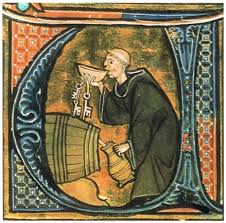I suppose the first thing that springs to mind when we think about ‘what the Romans did for us’ is that they left some rather straight roads. Did the Anglo-Saxons use them? I’d say absolutely yes. Why would they not? Let’s work backwards here.
With York being so important, not only to the Anglo-Saxons but then later to the ‘Vikings’ who had it as the centre of their kingdom, a road heading due south from York - Ermine Street - was bound to have seen heavy traffic, in particular, when Harold Godwinson marched his troops up to Stamford Bridge in 1066 and back down again to meet William of Normandy. Could he have moved his troops - men and horses - so quickly without using the Roman road (the most direct route)? And as fellow author Helen Hollick has pointed out, those roads must therefore have been well maintained.
Another Roman road, Watling Street, was, famously, the line used to divide up the kingdom when Alfred the Great came to an agreement with Guthrum the Dane in the ninth century so, again, we have to assume it was still in use in the late ninth century if it was used as a boundary marker.
We have more certain and tantalising proof that the Roman roads were still in use though. In 2009 one of the most exciting finds to date was dug up in a field. This was the seventh-century Staffordshire Hoard and it’s surely no coincidence that it was found just off the A5, more usually known as Watling Street. Imagine the scene: whoever buried the hoard made a quick getaway along the old road, intending to come back at some point to retrieve it… (It’s a scenario I portrayed in Cometh the Hour.)
The Staffordshire Hoard included many items - almost all of them military - inlaid with garnets, which brings me on to another aspect of Roman ‘remains’: jewels. From the seventh century on, for example, while glass beads remained popular, amethyst was incorporated, possibly from recycled Roman ornaments, but they were repurposed and worn strung lengthways with other beads, rather than dangling down, and pendants were also made from old Roman coins.
 |
| Staffordshire Hoard - Image Credit |
What else did the Anglo-Saxons upcycle?
They didn’t, on the whole, reuse the domestic buildings. If the buildings were in poor repair, why did they not rebuild? They certainly knew how to build, so that wasn’t the issue. Reconstructions, such as those at West Stow, and the excavation of great halls such as Yeavering, show that they were not incompetent builders. Tacitus said that none of the Germanic tribes on the continent lived in walled cities, so it’s more likely that the Anglo-Saxons preferred to live in buildings that kept them feeling close to the natural world. I also think that affected the way they communicated. Their lifestyle was one of community gatherings, of feasts in great halls, with many folk sleeping on benches or on the floor of the halls once the food and tables had been cleared away. It was where they exchanged stories, gifts, and heard songs and poems performed.
And here’s the crucial thing: the acoustic properties of wooden buildings also offer opportunities for intimate conversation. Sound will fall away, muffled by the absorbent materials in the building. Living communally provides companionship and a strong sense of belonging, but it must have been a boon to be able to conduct private conversations if the need or urge arose. Stone buildings have large spaces where sound echoes and resonates.
Churches, of course, are a different matter. Plenty of these were built in stone and an early example can be seen in the surviving crypt at Hexham Abbey, commissioned by Bishop Wilfrid in the seventh century. With a good ethos of ‘waste not, want not’ recycled Roman bricks were used, from the remains of the Roman fort and town at Corbridge just a few miles away; Wilfrid's church was probably built entirely from stones taken from this site.
 |
| The crypt at Hexham abbey - my photo |
A Roman town also played a part in a pivotal real-life scene in my novel Alvar the Kingmaker. It was the setting for a coronation, and not just any old coronation. King Edgar, who became king in 957, was crowned there in 973. Yes, 16 years after he ascended the throne. Can this be right?
Edgar had a chequered love life, with historians unable to agree whether he had two or three wives, and with earlier chroniclers suggesting that one of them was even a consecrated nun. For his supposed sins, he was allegedly given a seven-year penance, which delayed his coronation. But we know that by 964 he was married to his last wife, so that doesn’t explain the delay of the coronation until 973. Often-times, Anglo-Saxon kings had delayed coronations, but not usually for this length of time.
Edgar’s epithet was The Peaceable, and there were no Viking raids during his reign. He had control of Wessex, Mercia, Northumbria and East Anglia and, during another ceremony in 973, was famously rowed along the River Dee by 6-8 (depending on sources) other kings of the British Isles, who paid him homage. He was also probably 30 years old in that year, the canonical age for ordination. This might have been significant; a sort of symbol of spiritual maturity.
I suspect that this was a second coronation, and that Edgar’s age, and his supremacy over the kingdoms, was being marked. Bath was on the edge of the two major erstwhile Anglo-Saxon kingdoms of Wessex and Mercia, kingdoms which had traditionally voted for different candidates for the throne, including Edgar’s own accession, so its location would signify a unification. More than this, though, is the fact the Bath was a remnant of the Empire and this would have been a very clear sign that this was some kind of imperial coronation. It’s clear that the memory of the Romans was very much alive.
Not that this helped in the long run. With all those wives/women came a few children, which meant, ultimately, another fight for the throne. Alvar the Kingmaker certainly had his work cut out…
Find all my books (fiction, nonfiction and short stories) HERE








